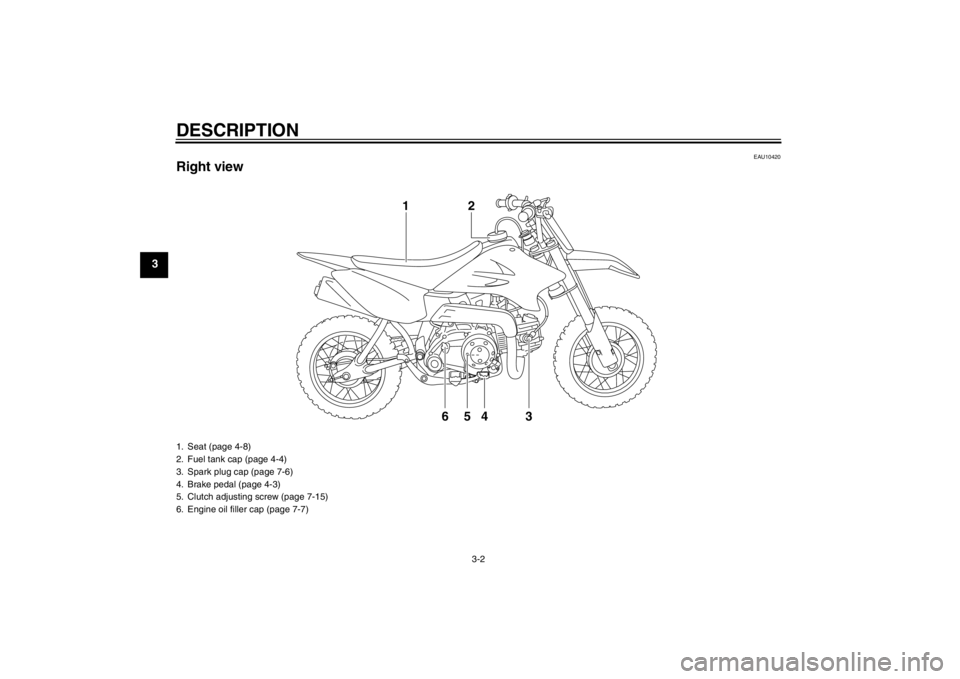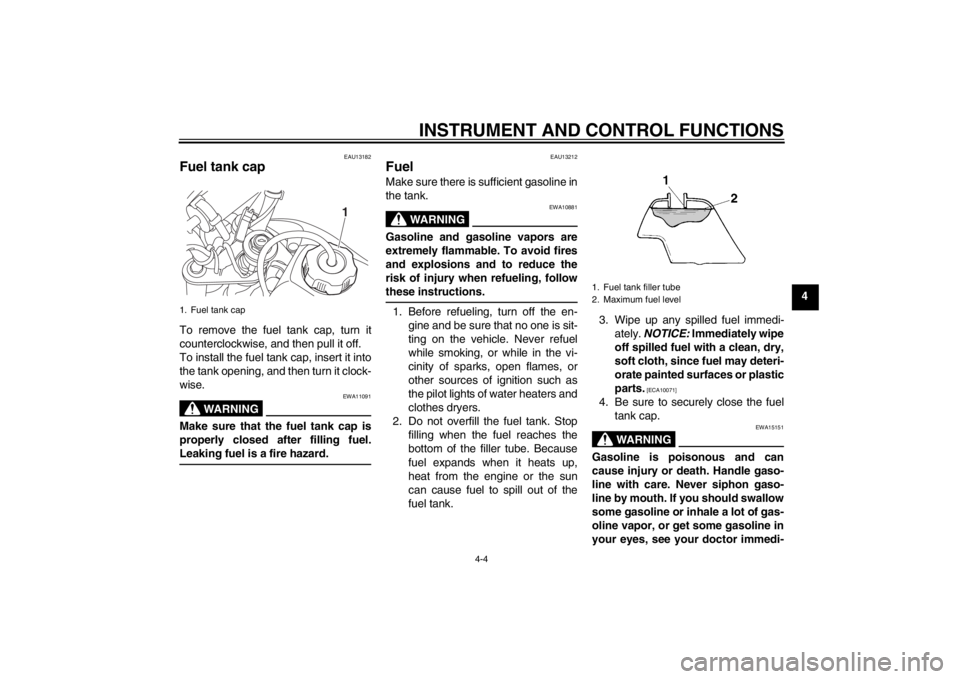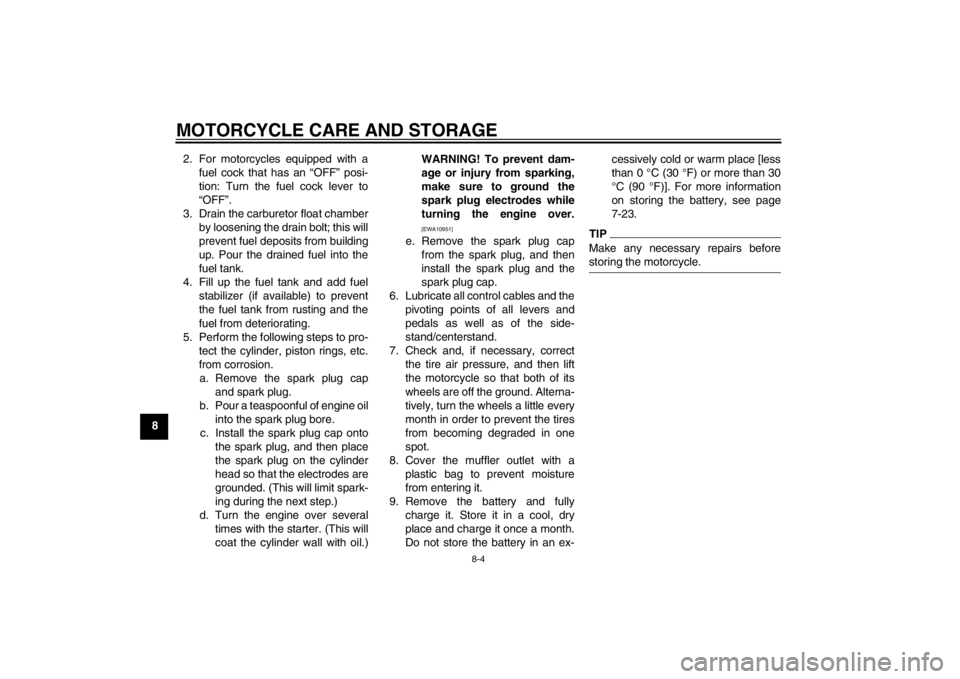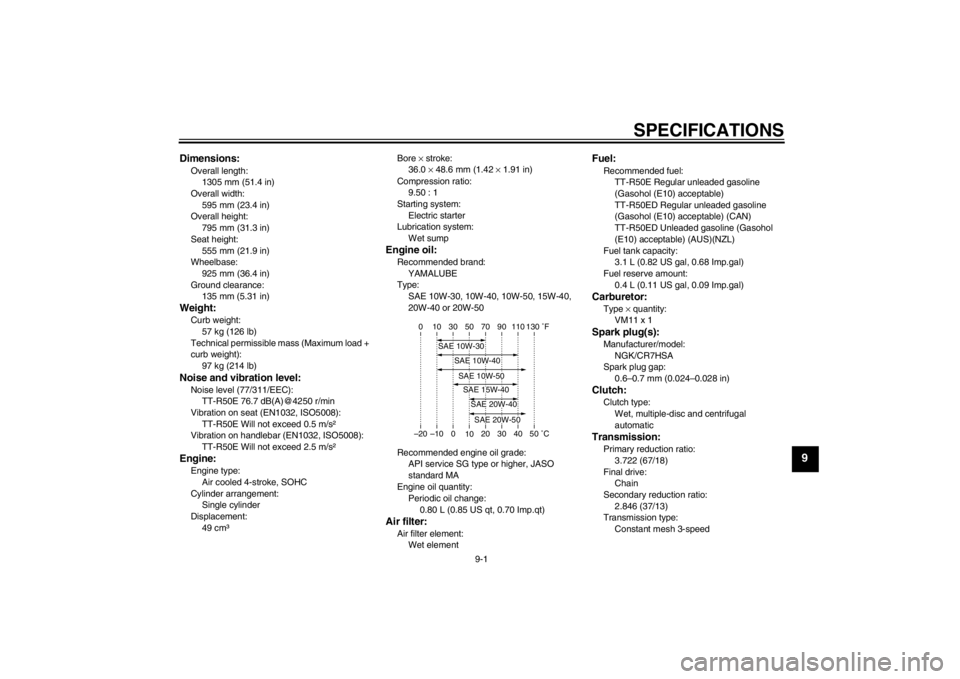fuel cap YAMAHA TTR50 2013 Owners Manual
[x] Cancel search | Manufacturer: YAMAHA, Model Year: 2013, Model line: TTR50, Model: YAMAHA TTR50 2013Pages: 86, PDF Size: 1.8 MB
Page 9 of 86

TABLE OF CONTENTS
LOCATION OF IMPORTANT
LABELS ............................................1-1
SAFETY INFORMATION .................. 2-1
DESCRIPTION .................................. 3-1
Left view .......................................... 3-1
Right view ........................................ 3-2
Controls and instruments ................3-3
INSTRUMENT AND CONTROL
FUNCTIONS ....................................... 4-1
Main switch ..................................... 4-1
Handlebar switches ........................ 4-1
Speed limiter .................................. 4-2
Shift pedal ......................................4-3
Brake lever ..................................... 4-3
Brake pedal .................................... 4-3
Fuel tank cap .................................. 4-4
Fuel ................................................ 4-4
Fuel tank breather hose ................. 4-7
Fuel cock ........................................ 4-7
Starter (choke) lever ....................... 4-8
Seat ................................................ 4-8
Sidestand ....................................... 4-9
Starting circuit cut-off system ......... 4-9 FOR YOUR SAFETY –
PRE-OPERATION CHECKS
............. 5-1
OPERATION AND IMPORTANT
RIDING POINTS ................................ 6-1
Starting and warming up a cold engine ......................................... 6-1
Starting a warm engine .................. 6-2
Shifting ........................................... 6-2
Engine break-in .............................. 6-3
Parking ........................................... 6-4
PERIODIC MAINTENANCE AND
ADJUSTMENT ................................... 7-1
Periodic maintenance chart for the emission control system ............. 7-2
General maintenance and
lubrication chart .......................... 7-3
Checking the spark plug ................ 7-6
Engine oil ....................................... 7-7
Cleaning the air filter element ........ 7-8
Cleaning the spark arrester ......... 7-10
Adjusting the carburetor ............... 7-11
Adjusting the engine idling speed ........................................ 7-11
Checking the throttle grip free
play ........................................... 7-12
Valve clearance ........................... 7-12
Tires ............................................. 7-13
Spoke wheels .............................. 7-14
Adjusting the clutch free play ....... 7-15 Adjusting the brake lever free
play ........................................... 7-15
Adjusting the brake pedal free play ........................................... 7-16
Checking the shift pedal ............... 7-17
Checking the front and rear brake
shoes ........................................ 7-17
Drive chain slack .......................... 7-18
Cleaning and lubricating the drive
chain ......................................... 7-19
Checking and lubricating the
cables ....................................... 7-20
Checking and lubricating the throttle grip and cable ............... 7-20
Checking and lubricating the brake lever ................................ 7-20
Checking and lubricating the
brake pedal ............................... 7-21
Checking and lubricating the sidestand .................................. 7-21
Lubricating the swingarm pivots ... 7-21
Checking the front fork ................. 7-22
Checking the steering .................. 7-22
Checking the wheel bearings ....... 7-23
Battery .......................................... 7-23
Replacing the fuse ....................... 7-24
Supporting the motorcycle ........... 7-25
Front wheel .................................. 7-26
Rear wheel ................................... 7-28
Troubleshooting ........................... 7-29
Troubleshooting chart .................. 7-31
U2CJ80E0.book Page 1 Tuesday, June 12, 2012 11:15 AM
Page 23 of 86

SAFETY INFORMATION
2-4
2
ucts or having other modifications per-
formed to your vehicle that change any
of the vehicle’s design or operation
characteristics can put you and others
at greater risk of serious injury or death.
You are responsible for injuries related
to changes in the vehicle.
Keep the following guidelines in mind,
as well as those provided under “Load-
ing” when mounting accessories.
●
Never install accessories that
would impair the performance of
your motorcycle. Carefully inspect
the accessory before using it to
make sure that it does not in any
way reduce ground clearance or
cornering clearance, limit suspen-
sion travel, steering travel or con-
trol operation.
Accessories fitted to the handle- bar or the front fork area can
create instability due to improper
weight distribution. If accesso-
ries are added to the handlebar
or front fork area, they must be
as lightweight as possible and
should be kept to a minimum. Bulky or large accessories may
seriously affect the stability of
the motorcycle. Wind may at-
tempt to lift the motorcycle, or
the motorcycle may become un-
stable in cross winds.
Certain accessories can dis- place the operator from his or
her normal riding position. This
improper position limits the free-
dom of movement of the opera-
tor and may limit control ability,
therefore, such accessories are
not recommended.
●
Use caution when adding electri-
cal accessories. If electrical acces-
sories exceed the capacity of the
motorcycle’s electrical system, an
electric failure could result, which
could cause a dangerous loss of
lights or engine power.
Aftermarket Tires and Rims
The tires and rims that came with your
motorcycle were designed to match the
performance capabilities and to provide
the best combination of handling, brak-
ing, and comfort. Other tires, rims, siz-
es, and combinations may not be appropriate. Refer to page 7-13 for tire
specifications and more information on
replacing your tires.
Transporting the Motorcycle
Be sure to observe following instruc-
tions before transporting the motorcy-
cle in another vehicle.
●
Remove all loose items from the
motorcycle.
●
Check that the fuel cock (if
equipped) is in the “OFF” position
and that there are no fuel leaks.
●
Point the front wheel straight
ahead on the trailer or in the truck
bed, and choke it in a rail to pre-
vent movement.
●
Shift the transmission in gear (for
models with a manual transmis-
sion).
●
Secure the motorcycle with tie-
downs or suitable straps that are
attached to solid parts of the mo-
torcycle, such as the frame or up-
per front fork triple clamp (and not,
for example, to rubber-mounted
handlebars or turn signals, or parts
that could break). Choose the lo-
U2CJ80E0.book Page 4 Tuesday, June 12, 2012 11:15 AM
Page 26 of 86

DESCRIPTION
3-2
3
EAU10420
Right view
4
65 3 2
1
1. Seat (page 4-8)
2. Fuel tank cap (page 4-4)
3. Spark plug cap (page 7-6)
4. Brake pedal (page 4-3)
5. Clutch adjusting screw (page 7-15)
6. Engine oil filler cap (page 7-7)U2CJ80E0.book Page 2 Tuesday, June 12, 2012 11:15 AM
Page 31 of 86

INSTRUMENT AND CONTROL FUNCTIONS
4-4
4
EAU13182
Fuel tank cap To remove the fuel tank cap, turn it
counterclockwise, and then pull it off.
To install the fuel tank cap, insert it into
the tank opening, and then turn it clock-
wise.
WARNING
EWA11091
Make sure that the fuel tank cap is
properly closed after filling fuel.
Leaking fuel is a fire hazard.
EAU13212
Fuel Make sure there is sufficient gasoline in
the tank.
WARNING
EWA10881
Gasoline and gasoline vapors are
extremely flammable. To avoid fires
and explosions and to reduce the
risk of injury when refueling, follow
these instructions.1. Before refueling, turn off the en-gine and be sure that no one is sit-
ting on the vehicle. Never refuel
while smoking, or while in the vi-
cinity of sparks, open flames, or
other sources of ignition such as
the pilot lights of water heaters and
clothes dryers.
2. Do not overfill the fuel tank. Stop filling when the fuel reaches the
bottom of the filler tube. Because
fuel expands when it heats up,
heat from the engine or the sun
can cause fuel to spill out of the
fuel tank. 3. Wipe up any spilled fuel immedi-
ately. NOTICE: Immediately wipe
off spilled fuel with a clean, dry,
soft cloth, since fuel may deteri-
orate painted surfaces or plastic
parts.
[ECA10071]
4. Be sure to securely close the fuel tank cap.
WARNING
EWA15151
Gasoline is poisonous and can
cause injury or death. Handle gaso-
line with care. Never siphon gaso-
line by mouth. If you should swallow
some gasoline or inhale a lot of gas-
oline vapor, or get some gasoline in
your eyes, see your doctor immedi-
1. Fuel tank cap
1
1. Fuel tank filler tube
2. Maximum fuel level
U2CJ80E0.book Page 4 Tuesday, June 12, 2012 11:15 AM
Page 32 of 86

INSTRUMENT AND CONTROL FUNCTIONS
4-5
4ately. If gasoline spills on your skin,
wash with soap and water. If gaso-
line spills on your clothing, change
your clothes.
EAU50251
For CanadaNOTICE
ECA11400
Use only unleaded gasoline. The use
of leaded gasoline will cause severe
damage to internal engine parts,
such as the valves and piston rings,
as well as to the exhaust system.Your Yamaha engine has been de-
signed to use regular unleaded gaso-
line with a pump octane number
[(R+M)/2] of 86 or higher, or a research
octane number of 91 or higher. If knocking (or pinging) occurs, use a
gasoline of a different brand or premi-
um unleaded fuel. Use of unleaded fuel
will extend spark plug life and reduce
maintenance costs.
Gasohol
There are two types of gasohol: gaso-
hol containing ethanol and that contain-
ing methanol. Gasohol containing
ethanol can be used if the ethanol con-
tent does not exceed 10% (E10). Gas-
ohol containing methanol is not
recommended by Yamaha because it
can cause damage to the fuel system
or vehicle performance problems.
For Europe
NOTICE
ECA11400
Use only unleaded gasoline. The use
of leaded gasoline will cause severe
damage to internal engine parts,
such as the valves and piston rings,
as well as to the exhaust system.Your Yamaha engine has been de-
signed to use regular unleaded gaso-
line with a research octane number of
95 or higher. If knocking (or pinging) oc-
curs, use a gasoline of a different brand
or premium unleaded fuel. Use of un-
leaded fuel will extend spark plug life
and reduce maintenance costs.
Gasohol
There are two types of gasohol: gaso-
hol containing ethanol and that contain-
ing methanol. Gasohol containing
ethanol can be used if the ethanol con-
tent does not exceed 10% (E10). Gas-
ohol containing methanol is not
recommended by Yamaha because it
can cause damage to the fuel system
or vehicle performance problems.
Recommended fuel:
Regular unleaded gasoline or gaso-
hol (E10)
Fuel tank capacity:
3.1 L (0.82 US gal, 0.68 Imp.gal)
Fuel reserve amount: 0.4 L (0.11 US gal, 0.09 Imp.gal)
Recommended fuel:
Regular unleaded gasoline or gaso-
hol (E10)
Fuel tank capacity:
3.1 L (0.82 US gal, 0.68 Imp.gal)
Fuel reserve amount: 0.4 L (0.11 US gal, 0.09 Imp.gal)
U2CJ80E0.book Page 5 Tuesday, June 12, 2012 11:15 AM
Page 33 of 86

INSTRUMENT AND CONTROL FUNCTIONS
4-6
4
For Oceania
NOTICE
ECA11400
Use only unleaded gasoline. The use
of leaded gasoline will cause severe
damage to internal engine parts,
such as the valves and piston rings,
as well as to the exhaust system.Your Yamaha engine has been de-
signed to use unleaded gasoline with a
research octane number of 91 or high-
er. If knocking (or pinging) occurs, use
a gasoline of a different brand or premi-
um unleaded fuel. Use of unleaded fuel
will extend spark plug life and reduce
maintenance costs.
Gasohol
There are two types of gasohol: gaso-
hol containing ethanol and that contain-
ing methanol. Gasohol containing
ethanol can be used if the ethanol con- tent does not exceed 10% (E10). Gas-
ohol containing methanol is not
recommended by Yamaha because it
can cause damage to the fuel system
or vehicle performance problems.
For South Africa
NOTICE
ECA11400
Use only unleaded gasoline. The use
of leaded gasoline will cause severe
damage to internal engine parts,
such as the valves and piston rings,
as well as to the exhaust system.Your Yamaha engine has been de-
signed to use regular unleaded gaso-
line with a research octane number of
91 or higher. If knocking (or pinging) oc-
curs, use a gasoline of a different brand
or premium unleaded fuel. Use of un-
leaded fuel will extend spark plug life
and reduce maintenance costs.
Gasohol
There are two types of gasohol: gaso-
hol containing ethanol and that contain-
ing methanol. Gasohol containing
ethanol can be used if the ethanol con-
tent does not exceed 10% (E10). Gas-
ohol containing methanol is not
recommended by Yamaha because it
can cause damage to the fuel system
or vehicle performance problems.
Recommended fuel:
Unleaded gasoline or gasohol (E10)
Fuel tank capacity: 3.1 L (0.82 US gal, 0.68 Imp.gal)
Fuel reserve amount: 0.4 L (0.11 US gal, 0.09 Imp.gal)
Recommended fuel:
Regular unleaded gasoline or gaso-
hol (E10)
Fuel tank capacity:
3.1 L (0.82 US gal, 0.68 Imp.gal)
Fuel reserve amount: 0.4 L (0.11 US gal, 0.09 Imp.gal)
U2CJ80E0.book Page 6 Tuesday, June 12, 2012 11:15 AM
Page 78 of 86

MOTORCYCLE CARE AND STORAGE
8-4
82. For motorcycles equipped with a
fuel cock that has an “OFF” posi-
tion: Turn the fuel cock lever to
“OFF”.
3. Drain the carburetor float chamber by loosening the drain bolt; this will
prevent fuel deposits from building
up. Pour the drained fuel into the
fuel tank.
4. Fill up the fuel tank and add fuel stabilizer (if available) to prevent
the fuel tank from rusting and the
fuel from deteriorating.
5. Perform the following steps to pro- tect the cylinder, piston rings, etc.
from corrosion.a. Remove the spark plug cap and spark plug.
b. Pour a teaspoonful of engine oil into the spark plug bore.
c. Install the spark plug cap onto the spark plug, and then place
the spark plug on the cylinder
head so that the electrodes are
grounded. (This will limit spark-
ing during the next step.)
d. Turn the engine over several times with the starter. (This will
coat the cylinder wall with oil.) WARNING! To prevent dam-
age or injury from sparking,
make sure to ground the
spark plug electrodes while
turning the engine over.
[EWA10951]
e. Remove the spark plug cap from the spark plug, and then
install the spark plug and the
spark plug cap.
6. Lubricate all control cables and the pivoting points of all levers and
pedals as well as of the side-
stand/centerstand.
7. Check and, if necessary, correct the tire air pressure, and then lift
the motorcycle so that both of its
wheels are off the ground. Alterna-
tively, turn the wheels a little every
month in order to prevent the tires
from becoming degraded in one
spot.
8. Cover the muffler outlet with a plastic bag to prevent moisture
from entering it.
9. Remove the battery and fully charge it. Store it in a cool, dry
place and charge it once a month.
Do not store the battery in an ex- cessively cold or warm place [less
than 0 °C (30 °F) or more than 30
°C (90 °F)]. For more information
on storing the battery, see page
7-23.
TIPMake any necessary repairs before
storing the motorcycle.
U2CJ80E0.book Page 4 Tuesday, June 12, 2012 11:15 AM
Page 79 of 86

SPECIFICATIONS
9-1
9
Dimensions:Overall length:1305 mm (51.4 in)
Overall width:
595 mm (23.4 in)
Overall height: 795 mm (31.3 in)
Seat height: 555 mm (21.9 in)
Wheelbase:
925 mm (36.4 in)
Ground clearance: 135 mm (5.31 in)Weight:Curb weight:
57 kg (126 lb)
Technical permissible mass (Maximum load +
curb weight):
97 kg (214 lb)Noise and vibration level:Noise level (77/311/EEC):TT-R50E 76.7 dB(A)@4250 r/min
Vibration on seat (EN1032, ISO5008):
TT-R50E Will not exceed 0.5 m/s²
Vibration on handlebar (EN1032, ISO5008): TT-R50E Will not exceed 2.5 m/s²Engine:Engine type:
Air cooled 4-stroke, SOHC
Cylinder arrangement: Single cylinder
Displacement: 49 cm³ Bore
× stroke:
36.0 × 48.6 mm (1.42 × 1.91 in)
Compression ratio: 9.50 : 1
Starting system:
Electric starter
Lubrication system: Wet sump
Engine oil:Recommended brand:
YAMALUBE
Type: SAE 10W-30, 10W-40, 10W-50, 15W-40,
20W-40 or 20W-50
Recommended engine oil grade: API service SG type or higher, JASO
standard MA
Engine oil quantity: Periodic oil change:
0.80 L (0.85 US qt, 0.70 Imp.qt)Air filter:Air filter element:Wet element
Fuel:Recommended fuel:TT-R50E Regular unleaded gasoline
(Gasohol (E10) acceptable)
TT-R50ED Regular unleaded gasoline
(Gasohol (E10) acceptable) (CAN)
TT-R50ED Unleaded gasoline (Gasohol
(E10) acceptable) (AUS)(NZL)
Fuel tank capacity: 3.1 L (0.82 US gal, 0.68 Imp.gal)
Fuel reserve amount: 0.4 L (0.11 US gal, 0.09 Imp.gal)Carburetor:Type × quantity:
VM11 x 1Spark plug(s):Manufacturer/model:
NGK/CR7HSA
Spark plug gap: 0.6–0.7 mm (0.024–0.028 in)Clutch:Clutch type:
Wet, multiple-disc and centrifugal
automaticTransmission:Primary reduction ratio:3.722 (67/18)
Final drive: Chain
Secondary reduction ratio:
2.846 (37/13)
Transmission type: Constant mesh 3-speed
–20 –10 0 1020 30 40 50 �C
10 30 50 70 90 110
0 130 �F
SAE 10W-30
SAE 15W-40SAE 20W-40SAE 20W-50
SAE 10W-40SAE 10W-50
U2CJ80E0.book Page 1 Tuesday, June 12, 2012 11:15 AM
Page 84 of 86

INDEXAAir filter element, cleaning....................... 7-8BBattery................................................... 7-23
Brake lever .............................................. 4-3
Brake lever, checking and lubricating ... 7-20
Brake lever free play, adjusting............. 7-15
Brake pedal ............................................. 4-3
Brake pedal, checking and lubricating ........................................... 7-21
Brake pedal free play, adjusting............ 7-16
Brake shoes, checking .......................... 7-17CCables, checking and lubricating .......... 7-20
Carburetor, adjusting ............................ 7-11
Care ........................................................ 8-1
Clutch free play, adjusting..................... 7-15DDrive chain, cleaning and lubricating .... 7-19
Drive chain slack ................................... 7-18EEngine break-in ....................................... 6-3
Engine idling speed............................... 7-11
Engine oil ................................................ 7-7
Engine, starting a warm .......................... 6-2
Engine stop switch .................................. 4-2FFront fork, checking .............................. 7-22
Fuel ......................................................... 4-4
Fuel cock................................................. 4-7
Fuel tank breather hose .......................... 4-7
Fuel tank cap .......................................... 4-4
Fuse, replacing ..................................... 7-24
HHandlebar switches ................................ 4-1IIdentification numbers .......................... 10-1LLabels, location....................................... 1-1MMain switch ............................................. 4-1
Maintenance and lubrication, periodic .... 7-3
Maintenance, emission control system... 7-2
Matte color, caution ................................ 8-1
Model label ........................................... 10-1PParking ................................................... 6-4
Part locations .......................................... 3-1SSafety information................................... 2-1
Seat ........................................................ 4-8
Shifting.................................................... 6-2
Shift pedal............................................... 4-3
Shift pedal, checking ............................ 7-17
Sidestand................................................ 4-9
Sidestand, checking and lubricating ..... 7-21
Spark arrester, cleaning ....................... 7-10
Spark plug, checking .............................. 7-6
Specifications ......................................... 9-1
Speed limiter........................................... 4-2
Starter (choke) lever ............................... 4-8
Starting and warming up a cold
engine .................................................. 6-1
Starting circuit cut-off system ................. 4-9
Start switch ............................................. 4-2
Steering, checking ................................ 7-22
Storage ................................................... 8-3 Supporting the motorcycle .................... 7-25
Swingarm pivots, lubricating ................. 7-21
TThrottle grip and cable, checking and
lubricating ........................................... 7-20
Throttle grip free play, checking ............ 7-12
Tires ...................................................... 7-13
Troubleshooting .................................... 7-29
Troubleshooting chart ........................... 7-31VValve clearance..................................... 7-12
Vehicle Emission Control Information
label (For Canada) .............................. 10-2
Vehicle identification number ................ 10-1WWheel bearings, checking ..................... 7-23
Wheel (front) ......................................... 7-26
Wheel (rear) .......................................... 7-28
Wheels .................................................. 7-14
U2CJ80E0.book Page 1 Tuesday, June 12, 2012 11:15 AM